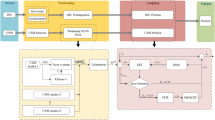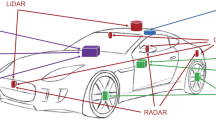Abstract
Wireless sensor networks (WSNs) have broad application prospects in various industries, and node localization technology is the foundation of WSN applications. Recently, many range-free node localization algorithms have been proposed, but most of them suffer from low accuracy. In order to improve the localization accuracy, in this paper we proposed the node localization algorithm based on multi-hop distance vector and error correction (MDV-EC). In terms of distance estimation, firstly the MDV-EC algorithm calculates the neighbor distance according to node neighbor relationship, then estimates the distance between unknown node and anchor node in multi-hop manner, and finally calibrates the distance refer to distance correction coefficient. In view of similarity of localization errors of nodes in similar regions, an error correction scheme is also investigated, which corrects the node initial estimated locations of nodes refer to the localization error vector of nearby anchor node. Simulation results show that our proposed MDV-EC has better performance than the other two algorithms in terms of node localization accuracy, and the error correction scheme can effectively reduce the localization errors.













Similar content being viewed by others
References
Praveen Kumar, D., Amgoth, T., & Annavarapu, C. S. R. (2019). Machine learning algorithms for wireless sensor networks: A survey. Information Fusion, 49, 1–25. https://doi.org/10.1016/j.inffus.2018.09.013
Zhang, K., Zhang, G., Yu, X., Hu, S., & Li, M. (2022). Clustering the sensor networks based on energy-aware affinity propagation. Computer Networks. https://doi.org/10.1016/j.comnet.2022.108853
Osamy, W., Khedr, A. M., Salim, A., Ali, A. I. A., & El-Sawy, A. A. (2022). Coverage, deployment and localization challenges in wireless sensor networks based on artificial intelligence techniques: A review. IEEE Access, 10, 30232–30257. https://doi.org/10.1109/access.2022.3156729
Liu, X., Han, F., Ji, W., Liu, Y., & Xie, Y. (2020). A novel range-free localization scheme based on anchor pairs condition decision in wireless sensor networks. IEEE Transactions on Communications, 68(12), 7882–7895. https://doi.org/10.1109/tcomm.2020.3020553
Kumar, P., Chaturvedi, A., & Kulkarni, M. (2012). Geographical location based hierarchical routing strategy for wireless sensor networks. In International Conference on Devices. IEEE.
Liu, J., Wang, Z., Yao, M., & Qiu, Z. (2015). VN-APIT: Virtual nodes-based range-free APIT localization scheme for WSN. Wireless Networks, 22(3), 867–878. https://doi.org/10.1007/s11276-015-1007-z
Luomala, J., & Hakala, I. (2019). Analysis and evaluation of adaptive RSSI-based ranging in outdoor wireless sensor networks. Ad Hoc Networks, 87, 100–112. https://doi.org/10.1016/j.adhoc.2018.10.004
Zhang, H., Wang, Z., & Gulliver, T. A. (2017). Two-stage weighted centroid localization for large-scale wireless sensor networks in ambient intelligence environment. Journal of Ambient Intelligence and Humanized Computing, 9(3), 617–627. https://doi.org/10.1007/s12652-017-0458-8
Nemer, I., Sheltami, T., Shakshuki, E., Elkhail, A. A., & Adam, M. (2020). Performance evaluation of range-free localization algorithms for wireless sensor networks. Personal and Ubiquitous Computing, 25(1), 177–203. https://doi.org/10.1007/s00779-020-01370-x
Niculescu, D., & Nath, B. (2003). DV based positioning in Ad hoc networks. Telecommunication Systems, 22, 267–280. https://doi.org/10.1023/A:1023403323460
Shahzad, F., Sheltami, T. R., & Shakshuki, E. M. (2017). DV-maxHop: A fast and accurate range-free localization algorithm for anisotropic wireless networks. IEEE Transactions on Mobile Computing, 16, 2494–2505.
Huang, X. (2020). Multi-node topology location model of smart city based on Internet of Things. Computer Communications, 152, 282–295. https://doi.org/10.1016/j.comcom.2020.01.052
Liu, G., Qian, Z., & Wang, X. (2019). An improved DV-hop localization algorithm based on hop distances correction. China Communications, 16(6), 200–214.
Cao, Y., & Wang, Z. (2019). Improved DV-hop localization algorithm based on dynamic anchor node set for wireless sensor networks. IEEE Access, 7, 124876–124890. https://doi.org/10.1109/access.2019.2938558
Chen, T., Hou, S., & Sun, L. (2022). An enhanced DV-hop positioning scheme based on spring model and reliable beacon node set. Computer Networks. https://doi.org/10.1016/j.comnet.2022.108926
Zhang, K., Zhang, G., Yu, X., & Hu, S. (2021). Boundary-based anchor selection method for wsns node localization. Arabian Journal for Science and Engineering, 46(4), 3779–3792. https://doi.org/10.1007/s13369-020-05286-9
Han, D., Yu, Y., Li, K. C., & de Mello, R. F. (2020). Enhancing the sensor node localization algorithm based on improved DV-hop and DE algorithms in wireless sensor networks. Sensors (Basel). https://doi.org/10.3390/s20020343
Singh, P., Mittal, N., & Singh, P. (2022). A novel hybrid range-free approach to locate sensor nodes in 3D WSN using GWO-FA algorithm. Telecommunication Systems. https://doi.org/10.1007/s11235-022-00888-0
Yang, J., Cai, Y., Tang, D., & Liu, Z. (2019). A novel centralized range-free static node localization algorithm with memetic algorithm and levy flight. Sensors (Basel). https://doi.org/10.3390/s19143242
Cui, H., Liang, Y., Zhou, C., & Cao, N. (2018). Localization of large-scale wireless sensor networks using niching particle swarm optimization and reliable anchor selection. Wireless Communications and Mobile Computing, 2018, 1–18. https://doi.org/10.1155/2018/2473875
Wang, Y., Wang, X., Wang, D., & Agrawal, D. P. (2009). Range-free localization using expected hop progress in wireless sensor networks. IEEE Transactions on Parallel and Distributed Systems, 20, 1540–1552. https://doi.org/10.1109/TPDS.2008.239
Wu, G., Wang, S., Wang, B., Dong, Y., & Yan, S. (2012). A novel range-free localization based on regulated neighborhood distance for wireless ad hoc and sensor networks. Computer Networks, 56(16), 3581–3593. https://doi.org/10.1016/j.comnet.2012.07.007
Yun, W., Xiaodong, W., Demin, W., & Agrawal, D. P. (2009). Range-free localization using expected hop progress in wireless sensor networks. IEEE Transactions on Parallel and Distributed Systems, 20(10), 1540–1552. https://doi.org/10.1109/tpds.2008.239
Wen, W., Wen, X., Yuan, L., & Xu, H. (2018). (2018) Range-free localization using expected hop progress in anisotropic wireless sensor networks. EURASIP Journal on Wireless Communications and Networking. https://doi.org/10.1186/s13638-018-1326-8
Zaidi, S., El Assaf, A., Affes, S., & Kandil, N. (2016). Accurate range-free localization in multi-hop wireless sensor networks. IEEE Transactions on Communications, 64, 3886–3900. https://doi.org/10.1109/TCOMM.2016.2590436
Acknowledgements
This work was supported by the Key Research and Development Projects of Hunan Province (2018SK2055); Ministry of Emergency Management of the People’s Republic of China Key Technologies for Safety Production and Major Accidents Prevention and Control (Hunan-0001-2018AQ); Hunan Provincial Natural Science Foundation of China (2021JJ50093).
Author information
Authors and Affiliations
Corresponding author
Ethics declarations
Conflict of interest
There is no conflict of interest exists in the submission of this manuscript, and all authors have approved the manuscript that is enclosed.
Additional information
Publisher's Note
Springer Nature remains neutral with regard to jurisdictional claims in published maps and institutional affiliations.
Rights and permissions
Springer Nature or its licensor holds exclusive rights to this article under a publishing agreement with the author(s) or other rightsholder(s); author self-archiving of the accepted manuscript version of this article is solely governed by the terms of such publishing agreement and applicable law.
About this article
Cite this article
Zhang, K., Zhang, G., Yu, X. et al. WSNs node localization algorithm based on multi-hop distance vector and error correction. Telecommun Syst 81, 461–474 (2022). https://doi.org/10.1007/s11235-022-00952-9
Accepted:
Published:
Issue Date:
DOI: https://doi.org/10.1007/s11235-022-00952-9




